


7.1. Strong Gravitational Lensing - A Primer
Slowly during the twentieth century, gravitational lensing moved from a curiosity associated with the verification of General Relativity (Eddington 1919) to a practical tool of cosmologists and those studying distant galaxies. There are many excellent reviews of both the pedagogical aspects of lensing (Blandford & Narayan 1998, Mellier 2000, Refregier 2003) and a previous Saas-Fee contributor (Schneider 2006).
To explore the distant Universe, we are primarily concerned with
strong lensing - where the lens has a projected mass density,
above a critical value,
 crit, so
that multiple
images and high source magnifications are possible. For a simple thin lens
crit, so
that multiple
images and high source magnifications are possible. For a simple thin lens
 |
where D represents the angular diameter distance and the subscripts
O,L,S refer to the observer, source and lens,
respectively. Rather conveniently, for a lens at z
 0.5 and a source at
z > 2, the critical projected density is about 1 g
cm-2 - a
value readily exceeded by most massive clusters. The merits of
exploring the distant Universe by imaging through clusters
was sketched in a remarkably prophetic article by
Zwicky (1937).
0.5 and a source at
z > 2, the critical projected density is about 1 g
cm-2 - a
value readily exceeded by most massive clusters. The merits of
exploring the distant Universe by imaging through clusters
was sketched in a remarkably prophetic article by
Zwicky (1937).
In lensing theory it is convenient to introduce a source plane, the true sky, and an image plane, the detector at our telescope, where the multiple images are seen. The relationship between the two is then a mapping transformation which depends on the relative distances (above). Crucially, what the observer sees depends on the degree of alignment between the source and lens as illustrated in Figure 46.
An elliptical lens with  >
>  crit
for a given source
and lens distance produces a pair of critical lines in the
image plane where the multiple images lie. These lines map
to caustics in the source plane. The outer critical
line is equivalent to the Einstein radius
crit
for a given source
and lens distance produces a pair of critical lines in the
image plane where the multiple images lie. These lines map
to caustics in the source plane. The outer critical
line is equivalent to the Einstein radius
 E
E
 |
and, for a given source and lens, is governed by the enclosed mass M. The location of the inner critical line depends on the gradient of the gravitational potential (Sand et al 2005).
The critical lines are important because they represent
areas of sky where very high magnifications can be
encountered - as high as ×30! For
 20
well-studied clusters the location of these lines can be precisely
determined for a given source redshift. Accordingly, it is practical to
survey just those areas to secure a glimpse of otherwise inaccessibly
faint sources boosted into view. The drawback is that, as in an
optical lens, the sky area is similarly magnified, so the surface
density of faint sources must be very large to yield any results. Regions
where the magnification exceed ×10 are typically only
0.1-0.3 arcmin2 per cluster in extent in the image plane
and inconveniently shaped for most instruments
(Figure 47).
The sampled area in the source plane is then ten times smaller so
to see even one magnified source/cluster requires a surface
density of distant sources of ~ 50 arcmin-2.
20
well-studied clusters the location of these lines can be precisely
determined for a given source redshift. Accordingly, it is practical to
survey just those areas to secure a glimpse of otherwise inaccessibly
faint sources boosted into view. The drawback is that, as in an
optical lens, the sky area is similarly magnified, so the surface
density of faint sources must be very large to yield any results. Regions
where the magnification exceed ×10 are typically only
0.1-0.3 arcmin2 per cluster in extent in the image plane
and inconveniently shaped for most instruments
(Figure 47).
The sampled area in the source plane is then ten times smaller so
to see even one magnified source/cluster requires a surface
density of distant sources of ~ 50 arcmin-2.
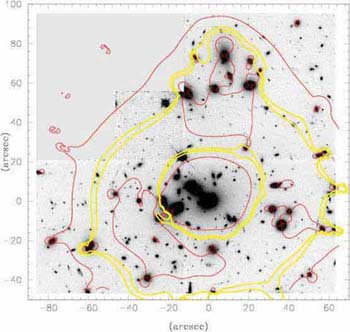 |
Figure 47. Hubble Space Telescope image of
the rich cluster
Abell 1689 with the critical lines for a source at
z
|
Two other applications are particularly useful in faint
galaxy studies. Firstly, strongly magnified systems at
z  2-3 can
provide remarkable insight into an
already studied population by providing an apparently
bright galaxy which is brought within reach of superior
instrumentation. cB58, a Lyman break galaxy at
z = 2.72 boosted by ×30 to V = 20.6
(Yee et al 1996,
Seitz et al 1998)
was the first distant galaxy to be studied with an echellette spectrograph
(Pettini et al 2002),
yielding chemical abundances and outflow dynamics of unprecedented
precision.
2-3 can
provide remarkable insight into an
already studied population by providing an apparently
bright galaxy which is brought within reach of superior
instrumentation. cB58, a Lyman break galaxy at
z = 2.72 boosted by ×30 to V = 20.6
(Yee et al 1996,
Seitz et al 1998)
was the first distant galaxy to be studied with an echellette spectrograph
(Pettini et al 2002),
yielding chemical abundances and outflow dynamics of unprecedented
precision.
More generally, a cluster can magnify a larger area of
 2-4 arcmin2
by a modest factor, say × 3-5. This has been effective in probing
sub-mm source counts to the faintest possible limits
(Smail et al 1997)
and the method shows promise for similar extensions with the IRAC
camera onboard Spitzer.
2-4 arcmin2
by a modest factor, say × 3-5. This has been effective in probing
sub-mm source counts to the faintest possible limits
(Smail et al 1997)
and the method shows promise for similar extensions with the IRAC
camera onboard Spitzer.
7.2. Creating a Cluster Mass Model
In the applications discussed above, in order to analyze the results, the inferred magnification clearly has to be determined. This will vary as a function of position in the cluster image and the relative distances of source and lens. The magnification follows from the construction of a mass model for the cluster.
The precepts for this method are discussed in the detailed analysis of the remarkable image of Abell 2218 taken with the WFPC-2 camera onboard HST in 1995 (Kneib et al 1996). An earlier image of AC 114 showed the important role HST would play in the recognition of multiple images (Smail et al 1995). Prior to HST, multiple images could only be located by searching for systems with similar colors, using the fact that lensing is an achromatic phenomenon. HST revealed that morphology is a valuable additional identifier; the improved resolution also reveals the local shear (see Figure 48).
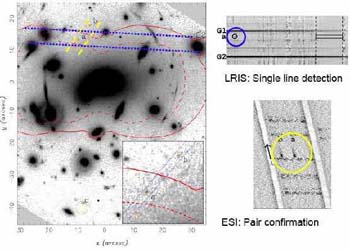 |
Figure 48. Hubble Space Telescope study of the rich cluster AC114 (Smail et al 2005). (Top) Morphological recognition of a triply-imaged source. The lower inset panels zoom in on each of 3 images of the same source. (Bottom) Construction of mass contours (red lines) and associated shear (red vectors) from the geometrical arrangement of further multiple images labelled A1-3, B1-4, C1-3, Q1-3. |
Today, various approaches are possible for constructing precise mass models for lensing clusters (Kneib et al 1996, Jullo et al 2006, Broadhurst et al 2005). These are generally based on utilizing the geometrical positions of sets of multiply-imaged systems whose redshift is known or assumed. This then maps the form and diameter of the critical line for a given z. Spectroscopic redshifts are particularly advantageous, as are pairs that straddle the critical line whose location can then be very precisely pinpointed. A particular mass model can be validated by `inverting' the technique and predicting the redshifts of other pairs prior to subsequent spectroscopy (Ebbels et al 1998).
The main debate among cognescenti in this area lies in the extent to which one should adopt a parametric approach to fitting the mass distribution, particularly in relation to the incorporation of mass clumps associated with individual cluster galaxy halos (Broadhurst et al 2005). Stark et al (2006b) discuss the likely uncertainties in the mass modeling process arising from the various techniques.
7.3. Lensing in Action: Some High z Examples
Before turning to Lyman  emitters (lensed and unlensed), we
will briefly discuss what has been learned from strongly-lensed dropouts.
emitters (lensed and unlensed), we
will briefly discuss what has been learned from strongly-lensed dropouts.
Figure 49 shows a lensed pair in the cluster
Abell 2218 (z = 0.18)
as detected by NICMOS onboard HST and the two shortest wavelength
channels of IRAC
(Kneib et al 2004,
Egami et al 2005).
Although no spectroscopic redshift is yet available for this source,
three images have been located by HST and their arrangement around the
well-constrained z = 6 critical line suggests a source beyond
z  6
(Kneib et al 2004).
6
(Kneib et al 2004).
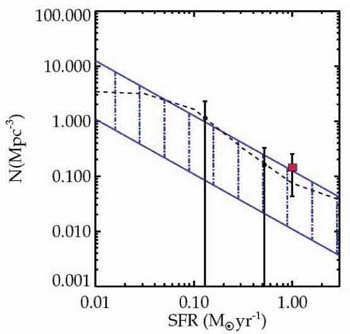 |
Figure 49. (Top) Lensed pair of a z =
6.8 source as seen by NICMOS and IRAC in the rich cluster
Abell 2218
(Egami et al 2005).
The pair straddles the critical line at z
|
As with the unlensed i-band drop out studies by
Eyles et al (2005) and
Yan et al (2005),
the prominent IRAC detections
(Egami et al 2005)
permit an improved photometric redshift and important constraints
on the stellar mass and age. A redshift of z = 6.8 ± 0.1
is derived, independently of the geometric constraints used by
Kneib et al. The stellar mass is
 5-10 108
M
5-10 108
M and
the current star formation rate is
and
the current star formation rate is
 2.6
M
2.6
M yr-1.
The luminosity-weighted age corresponds to anything from 40-450 Myr
for a normal IMF depending on the star formation history. Interestingly,
the derived age for such a prominent Balmer break generally
exceeds the e-folding timescale of the star formation history
(Fig. 49)
indicating the source would have been more luminous at redshifts
7 < z < 12 (unless obscured).
yr-1.
The luminosity-weighted age corresponds to anything from 40-450 Myr
for a normal IMF depending on the star formation history. Interestingly,
the derived age for such a prominent Balmer break generally
exceeds the e-folding timescale of the star formation history
(Fig. 49)
indicating the source would have been more luminous at redshifts
7 < z < 12 (unless obscured).
Given the small search area used to locate this object, such low mass
sources may be very common. Accordingly, several groups are now surveying
more lensing clusters for further examples of z band dropouts and
even J-band dropouts (corresponding to z
 8-10) . Richard et al
are surveying 6 clusters with NICMOS and IRAC with deep ground-based
K band
imaging from Subaru and Keck. In these situations, one has to distinguish
between magnifications of ×5 or so expected across the 2-3 arcmin
fields of NICMOS and IRAC, and the much larger magnifications possible
close to the critical lines. Contamination from foreground sources should
be similar to what is seen in the GOODS surveys discussed in Lecture
6. The discovery of image pairs in the highly-magnified regions would be
a significant step forward since spectroscopic confirmation of any
sources at the limits being probed (HAB
8-10) . Richard et al
are surveying 6 clusters with NICMOS and IRAC with deep ground-based
K band
imaging from Subaru and Keck. In these situations, one has to distinguish
between magnifications of ×5 or so expected across the 2-3 arcmin
fields of NICMOS and IRAC, and the much larger magnifications possible
close to the critical lines. Contamination from foreground sources should
be similar to what is seen in the GOODS surveys discussed in Lecture
6. The discovery of image pairs in the highly-magnified regions would be
a significant step forward since spectroscopic confirmation of any
sources at the limits being probed (HAB
 26.5-27.0) will be
exceedingly difficult.
26.5-27.0) will be
exceedingly difficult.
The origin and characteristic properties of the Lyman
 emission line
has been discussed by my colleagues in their lectures (see also
Miralda-Escude 1998,
Haiman 2002,
Barkana & Loeb 2004
and Santos 2004).
The n = 2 to 1 transition corresponding to an energy difference
of 10.2 eV and rest-wavelength of
emission line
has been discussed by my colleagues in their lectures (see also
Miralda-Escude 1998,
Haiman 2002,
Barkana & Loeb 2004
and Santos 2004).
The n = 2 to 1 transition corresponding to an energy difference
of 10.2 eV and rest-wavelength of
 1216 Å typically
arises from ionizing photons absorbed by nearby
hydrogen gas. The line has a number of interesting features which make it
particularly well-suited for locating early star forming galaxies as well as
for characterizing the nature of the IGM.
1216 Å typically
arises from ionizing photons absorbed by nearby
hydrogen gas. The line has a number of interesting features which make it
particularly well-suited for locating early star forming galaxies as well as
for characterizing the nature of the IGM.
In searching for distant galaxies, emission lines offer far more contrast
against the background sky than the faint stellar continuum of a drop-out.
A line gives a convincing spectroscopic redshift (assuming it is correctly
identified) and models suggest that as much as 7% of the bolometric
output of young star-forming region might emerge in this line. For a normal
IMF and no dust, a source with a star formation rate (SFR) of 1
M yr-1 yields an emission line luminosity of 1.5 ×
1042 ergs sec-1.
yr-1 yields an emission line luminosity of 1.5 ×
1042 ergs sec-1.
Narrow band imaging techniques (see below) can reach fluxes of <
10-17 cgs in comoving survey volumes of
 105
Mpc3, corresponding to a SFR
105
Mpc3, corresponding to a SFR
 3
M
3
M yr-1 at z
yr-1 at z
 6.
Spectroscopic techniques can probe fainter due to the improved
contrast. This is particularly so along the critical lines where the
additional boost of gravitational lensing enables fluxes as faint as 3
× 10-19 cgs to be reached (corresponding to SFR
6.
Spectroscopic techniques can probe fainter due to the improved
contrast. This is particularly so along the critical lines where the
additional boost of gravitational lensing enables fluxes as faint as 3
× 10-19 cgs to be reached (corresponding to SFR
 0.1
M
0.1
M yr-1).
However, in this case the survey volumes are much smaller
(
yr-1).
However, in this case the survey volumes are much smaller
(  50 Mpc3).
In this sense, the two techniques (discussed below) are usefully
complementary.
50 Mpc3).
In this sense, the two techniques (discussed below) are usefully
complementary.
Having a large dynamic range in surveys for
Ly emission is important
not just to probe the luminosity function of star-forming galaxies but
also because it can be used to characterize the IGM. As a resonant
transition, foreground hydrogen gas clouds can scatter away
Ly
emission is important
not just to probe the luminosity function of star-forming galaxies but
also because it can be used to characterize the IGM. As a resonant
transition, foreground hydrogen gas clouds can scatter away
Ly photons in both
direction and frequency. In a partially ionized IGM, scattering is
maximum at
photons in both
direction and frequency. In a partially ionized IGM, scattering is
maximum at  1216 Å
in the rest-frame of the foreground cloud, thus affecting the
blue wing of the observed line. However, in a fully neutral IGM,
scattering far from resonance can occur leading to damping over the
entire observed line. Figure 50 illustrates
how, in a hypothetical situation where the IGM becomes substantially
neutral during 6 < z < 7, surveys reaching the narrow-band
flux limit would still find emitters at z = 7. Their intense
emission would only be partially
damped by even a neutral medium. However, lines with fluxes
at the spectroscopic lensing limit would not survive. Accordingly, one
possible signature of reionization would be a significant change in the
shape of the Ly
1216 Å
in the rest-frame of the foreground cloud, thus affecting the
blue wing of the observed line. However, in a fully neutral IGM,
scattering far from resonance can occur leading to damping over the
entire observed line. Figure 50 illustrates
how, in a hypothetical situation where the IGM becomes substantially
neutral during 6 < z < 7, surveys reaching the narrow-band
flux limit would still find emitters at z = 7. Their intense
emission would only be partially
damped by even a neutral medium. However, lines with fluxes
at the spectroscopic lensing limit would not survive. Accordingly, one
possible signature of reionization would be a significant change in the
shape of the Ly luminosity function at the faint end
(Furlanetto et al 2005).
luminosity function at the faint end
(Furlanetto et al 2005).
7.5. Results from Narrow Band
Ly Surveys
Surveys
The most impressive results to date have come from various narrow-band filters placed within the SuPrime camera at the prime focus of the Subaru 8m telescope (Kodaira et al 2003, Hu et al 2004, Ouchi et al 2005, Taniguchi et al 2005, Shimasaku et al 2005, Kashikawa et al 2006, Iye et al 2006). Important conclusions have also been deduced from an independent 4m campaign (Malhotra & Rhoads 2004).
Narrow band filters are typically manufactured at wavelengths where
the night sky spectrum is quiescent, thus maximizing the contrast. These
locations correspond to redshifts of z = 4.7, 5.7, 6.6 and 6.9
(Fig. 52). A recent
triumph was the successful recovery of two candidates at z
 6.96 by
Iye et al (2006).
Candidates are selected by comparing their
narrow band fluxes with that in a broader band encompassing the
narrow band wavelength range. The contrast can then be used as
an indicator of line emission (Fig. 53).
Spectroscopic follow-up is still desirable as the line could arise in a
foregound galaxy with [O II] 3727 Å or [O III] 5007 Å
emission. The former line is a doublet and the latter is part of a pair
with a fixed line ratio, separated in the rest-frame by only 60 Å
or so, so these contaminants are readily identified. Furthermore,
Ly
6.96 by
Iye et al (2006).
Candidates are selected by comparing their
narrow band fluxes with that in a broader band encompassing the
narrow band wavelength range. The contrast can then be used as
an indicator of line emission (Fig. 53).
Spectroscopic follow-up is still desirable as the line could arise in a
foregound galaxy with [O II] 3727 Å or [O III] 5007 Å
emission. The former line is a doublet and the latter is part of a pair
with a fixed line ratio, separated in the rest-frame by only 60 Å
or so, so these contaminants are readily identified. Furthermore,
Ly is often
revealed by its asymmetric profile (c.f. Fig. 51).
is often
revealed by its asymmetric profile (c.f. Fig. 51).
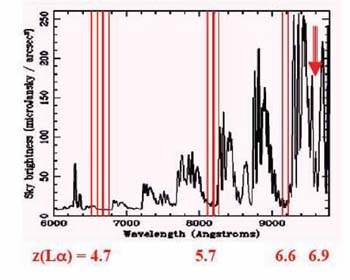 |
Figure 51. Night sky spectrum and the
deployment of narrow band filters in `quiet' regions corresponding to
redshifted Lyman |
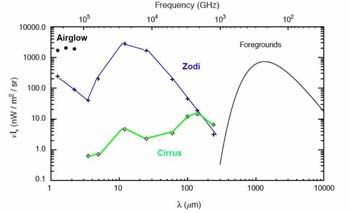 |
Figure 52. The two-step process for
locating high redshift Lyman
|
Spectroscopic follow-up is obviously time-intensive for a large
sample of candidates, hundreds of which can now be found with
panoramic imagers such as SuPrimeCam. Therefore it is worth
investigating additional ways of eliminating foreground sources.
Tanuguchi et al (2005)
combine the narrow band criteria adopted in
Fig. 53
with a broad-band i - z drop-out signature. Spectroscopic follow-up
of candidates located via this double color cut revealed a 50-70%
success rate
for locating high z emitters. The drawback is that the sources so
found cannot easily be compared in number with other, more traditional,
methods.
Nagao et al (2005)
used a narrow - broad band color
criterion in the opposite sense, locating sources with a narrow
band depression (rather than excess). Such rare sources
are confirmed to be sources with extremely intense emission
elsewhere in the broad-band filter. Such sources, with Lyman
 equivalent widths in
excess of several hundred Å
are interesting because they may challenge what can be produced
from normal stellar populations.
equivalent widths in
excess of several hundred Å
are interesting because they may challenge what can be produced
from normal stellar populations.
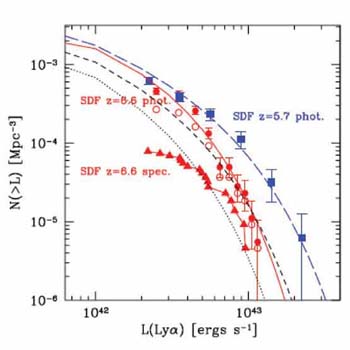 |
Figure 53. Comparison of the Lyman
|
Malhotra & Rhoads
(2004)
were the first to consider the absence
of evolution in the Ly LF as a constraint on the neutral
fraction. Although they found no convincing change in the LF
between z = 5.7 and 6.5, the statistical uncertainties in both
LFs were considerable. Specifically, below luminosities of
LLy
LF as a constraint on the neutral
fraction. Although they found no convincing change in the LF
between z = 5.7 and 6.5, the statistical uncertainties in both
LFs were considerable. Specifically, below luminosities of
LLy
 1042.5 ergs
sec-1 no detections were then available.
Hu et al (2005)
have also appealed to the absence of any significant change in the mean
Ly
1042.5 ergs
sec-1 no detections were then available.
Hu et al (2005)
have also appealed to the absence of any significant change in the mean
Ly profile.
Malhotra & Rhoads deduced the neutral fraction must be
xHI < 0.3
at z
profile.
Malhotra & Rhoads deduced the neutral fraction must be
xHI < 0.3
at z  6
supporting early reionization. However,
Furlanetto et al (2005)
reanalyzed this constraint and indicated
that strong emitters could persist even when xHI
6
supporting early reionization. However,
Furlanetto et al (2005)
reanalyzed this constraint and indicated
that strong emitters could persist even when xHI
 0.5
(c.f. Fig. 51).
0.5
(c.f. Fig. 51).
Kashikawa et al (2006)
and Shimasaku et al (2005)
have determined statistically greatly improved
Lyman  luminosity
functions and discuss both spectroscopic confirmed and
photometrically-selected emitters (Fig. 53).
No decline is apparent in the abundance of low luminosity emitters as
expected in an IGM with high xHI; indeed the most
significant change is a decline with redshift in the abundance of the
most luminous systems. Although the change seems surprisingly rapid given
the time interval is only 150 Myr, this is consistent with
growth in the halo mass function
(Dijsktra et al 2006).
luminosity
functions and discuss both spectroscopic confirmed and
photometrically-selected emitters (Fig. 53).
No decline is apparent in the abundance of low luminosity emitters as
expected in an IGM with high xHI; indeed the most
significant change is a decline with redshift in the abundance of the
most luminous systems. Although the change seems surprisingly rapid given
the time interval is only 150 Myr, this is consistent with
growth in the halo mass function
(Dijsktra et al 2006).
7.6. Results from Lensed
Ly Surveys
Surveys
The principal gain of narrow band imaging over other techniques in locating
high redshift
Lyman  emitters lies in
the ability to exploit panoramic
cameras with fields of view as large as 30-60 arcmin. Since cosmic lenses
only magnify fields of a few arcmin or less, lensing searches are only
of practical utility when used in spectroscopic mode. As discussed
above, the gain in sensitivity can be factors of ×30 or more, and given
the small volumes explored, they are primarily useful in testing the
faint end of the Ly
emitters lies in
the ability to exploit panoramic
cameras with fields of view as large as 30-60 arcmin. Since cosmic lenses
only magnify fields of a few arcmin or less, lensing searches are only
of practical utility when used in spectroscopic mode. As discussed
above, the gain in sensitivity can be factors of ×30 or more, and given
the small volumes explored, they are primarily useful in testing the
faint end of the Ly luminosity function at various redshifts. A number of workers (e.g.
Barkana & Loeb 2004)
have emphasized the likelihood that the bulk of the reionizing photons
arise from an abundant
population of intrinsically-faint sources, and lensed searches provide
the only practical route to observationally testing this hypothesis.
luminosity function at various redshifts. A number of workers (e.g.
Barkana & Loeb 2004)
have emphasized the likelihood that the bulk of the reionizing photons
arise from an abundant
population of intrinsically-faint sources, and lensed searches provide
the only practical route to observationally testing this hypothesis.
A practical demonstration of a blind search for lensed
Ly emitters is
summarized in Figure 54. A long slit is
oriented along a straight portion of the critical line (whose location
depends on the source redshift). The survey comprises several
exposures taken in different positions offset perpendicular to the
critical line. Candidate emission lines are astrometrically located
on a deep HST image and, if a counter-image consistent with the
mass model can be located, a separate exposure is undertaken
to capture both (as was the case in the source located by
Ellis et al 2001).
Unfortunately, continuum emission is rarely seen from a faint
emitter and the location of a corresponding second image is
often too uncertain to warrant a separate search. In this case
contamination from foreground sources has to be inferred from
the absence of corresponding lines at other wavelengths
(Santos et al 2004,
Stark et al 2006b).
emitters is
summarized in Figure 54. A long slit is
oriented along a straight portion of the critical line (whose location
depends on the source redshift). The survey comprises several
exposures taken in different positions offset perpendicular to the
critical line. Candidate emission lines are astrometrically located
on a deep HST image and, if a counter-image consistent with the
mass model can be located, a separate exposure is undertaken
to capture both (as was the case in the source located by
Ellis et al 2001).
Unfortunately, continuum emission is rarely seen from a faint
emitter and the location of a corresponding second image is
often too uncertain to warrant a separate search. In this case
contamination from foreground sources has to be inferred from
the absence of corresponding lines at other wavelengths
(Santos et al 2004,
Stark et al 2006b).
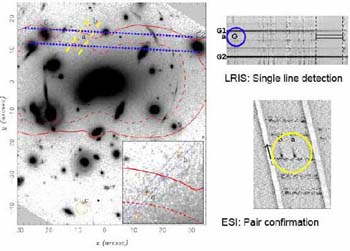 |
Figure 54. Critical line mapping in Abell 2218: how it works (Ellis et al 2001). The red curves show the location of the lines of very high magnification for a source at a redshift z=1 (dashed) and z = 6 (solid). Blue lines show the region scanned at low resolution with a long-slit spectrograph. The upper right panel shows the detection of an isolated line astrometrically associated with (a) in the HST image for which a counter image (b) is predicted and recovered (see also inset to main panel). A higher dispersion spectrum aligned between the pair (yellow lines) reveal strong emission with an asymmetric profile in both (lower right panel). |
Using this technique with an optical spectrograph sensitive to
Ly from 2.2 <
z < 6.7,
Santos et al (2004)
conducted a survey of 9 lensing clusters and found 11 emitters probing
luminosities as faint as LLy
from 2.2 <
z < 6.7,
Santos et al (2004)
conducted a survey of 9 lensing clusters and found 11 emitters probing
luminosities as faint as LLy
 1040 cgs,
significantly fainter
than even the more recent Subaru narrow band imaging searches
(Shimasaku et al 2006).
The resulting luminosity function is
flatter at the faint end than implied for the halo mass function
and is consistent with suppression of star formation in the lowest
mass halos.
1040 cgs,
significantly fainter
than even the more recent Subaru narrow band imaging searches
(Shimasaku et al 2006).
The resulting luminosity function is
flatter at the faint end than implied for the halo mass function
and is consistent with suppression of star formation in the lowest
mass halos.
Stark et al (2006b)
have extended this technique to higher
redshift using an infrared spectrograph operating in the J
band, where lensed Ly emitters in the range 8.5 < z < 10.2
would be found. This is a much more demanding experiment
than that conducted in the optical because of the brighter and
more variable sky brightness, the smaller slit length necessitating
very precise positioning to maximize the magnifications and, obviously,
the fainter sources given the increased redshift. Nonetheless, a
5
emitters in the range 8.5 < z < 10.2
would be found. This is a much more demanding experiment
than that conducted in the optical because of the brighter and
more variable sky brightness, the smaller slit length necessitating
very precise positioning to maximize the magnifications and, obviously,
the fainter sources given the increased redshift. Nonetheless, a
5 sensitivity limit
fainter than 10-17 cgs corresponding
to intrinsic (unlensed) star formation rates of 0.1
M
sensitivity limit
fainter than 10-17 cgs corresponding
to intrinsic (unlensed) star formation rates of 0.1
M yr-1 is achieved with the 10m Keck II telescope in exposure
times of 1.5 hours per slit position.
yr-1 is achieved with the 10m Keck II telescope in exposure
times of 1.5 hours per slit position.
After surveying 10 clusters with several slit positions per cluster, 6 candidate emission lines have been found and, via additional spectroscopy, it seems most cannot be explained as foreground sources. Stark et al estimate the survey volume taking into account both the spatially-dependent magnification (from the cluster mass models) and the redshift-dependent survey sensitivity (governed by the night sky spectrum within the spectral band).
Madau et al (1999) and Stiavelli et al (2004) have introduced simple prescriptions for estimating the abundance of star forming sources necessary for cosmic reionizations. While these prescriptions are certainly simple-minded, given the coarse datasets at hand, they provide an illustration of the implications.
Generally, the abundance of sources of a given star formation
rate SFR necessary for cosmic reionization over a time interval
 t is
t is
 |
where B is the number of ionizing photons required to
keep a single hydrogen atom ionized, nH is the
comoving number density of hydrogen at the redshift
of interest and fc is the escape fraction of
ionizing photons. Figure 55 shows the upshot of
the
Stark et al (2006b)
survey for various assumptions. The detection of even a few convincing
sources with SFR  0.1-1
M
0.1-1
M yr-1 in such small cosmic volumes would imply a significant
contribution from feeble emitters at z
yr-1 in such small cosmic volumes would imply a significant
contribution from feeble emitters at z
 10. Although
speculative at this stage given both the uncertain nature
of the lensed emitters and the calculation above, it nonetheless
provides a strong incentive for continued searches.
10. Although
speculative at this stage given both the uncertain nature
of the lensed emitters and the calculation above, it nonetheless
provides a strong incentive for continued searches.
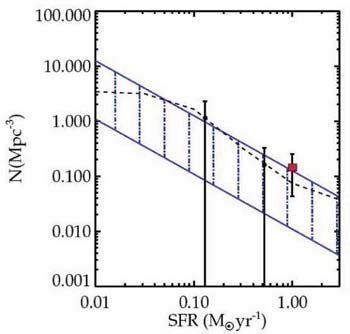 |
Figure 55. The volume density of sources
of various star formation rates at z
|
In this lecture we have shown how
Lyman  emission
offers more than simply a way to locate distant galaxies. The
distribution of line profiles, equivalent widths and its luminosity
function can act as a sensitive gauge of the neutral fraction
because of the effects of scattering by hydrogen clouds. Surveys
have been undertaken using optical cameras and narrow
band filters to redshifts z
emission
offers more than simply a way to locate distant galaxies. The
distribution of line profiles, equivalent widths and its luminosity
function can act as a sensitive gauge of the neutral fraction
because of the effects of scattering by hydrogen clouds. Surveys
have been undertaken using optical cameras and narrow
band filters to redshifts z
 7.
7.
However, despite great progress in the narrow-band surveys,
as with the earlier i-band drop outs, there is some dispute
as to the evolutionary trends being found. Surprisingly strong
evolution is seen in luminous emitters over a very short period
of cosmic time corresponding to 5.7 < z < 6.5. And, to date
there is no convincing evidence that line profiles are
evolving or that the equivalent width distribution of emitters
is skewed beyond what can be accounted for by normal
young stellar populations. One suspects we will have to
push these techniques to higher redshift which will be hard
given the Ly line moves
into the infrared where no
such panoramic instruments are yet available.
line moves
into the infrared where no
such panoramic instruments are yet available.
We have also given a brief tutorial on strong gravitational
lensing. In about 20 or so clusters, spectroscopic redshifts
for sets of multiple images has enabled quite precise mass
models to be determined which, in turn, enable accurate
magnification maps to be derived. Remarkably faint sources
can be found by searching along the so-called critical lines
where the magnification is high. The techniques has revealed
a few intrinsically faint sources and, possibly, the first glimpse of a
high abundance of faint star forming sources at z
 10 has been secured.
10 has been secured.